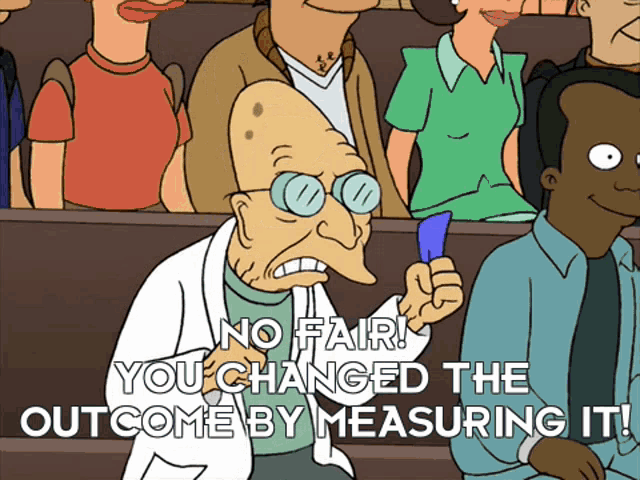
For those confused, it’s worth noting the difference between observed as a layman concept and as a quantum mechanical one.
In QM, to observed is to couple the observer to the “system” being observed. Think of it like “observing” your neighbour, over a fence using a BB gun. When you hit flesh, you know where your neighbour is. Unfortunately, the system has now been fundamentally changed. In a classical system, you could turn down the power, until your neighbour doesn’t notice the hits. Unfortunately, QM imposes fundamental limits on your measurements (heisenburg and his uncertainty principal). In order to observe your neighbour accurately, you need to hit them hard enough that the will also feel it and react differently.
QM behaves in a similar way. Initially, the system is just a single particle, and is not very restrained. This allows it to behave in a very wave like manner. When you observe it, the system now includes the whole observation system, as this coupling propagates, more and more atoms etc get linked. The various restraints cause an effect called decoherence. The system behaves ever more like a classical physical system.
In short, a quantum mechanical “observer” is less sneaky watching, and more hosing down with a machine gun and watching the ricochets.
Thanks! I’ve never fully grasped the concept and this really helps.
I’ve always heard it that observing was actually “measuring” and still wasn’t sure why that would impact anything but chalked it up to the quantum world being other-worldly.
Honestly physicists don’t actually know what measuring is either. We don’t know when exactly the system is considered “measured” in the chain of entanglement, this is called the Measurement Problem.
Answers range from “shut up don’t think about it” to “there’s an infinite amount of universes split from each other for each quantum event!”.
We know how it works, we just don’t yet understand what is going on under the hood.
In short, quantum effects can be very obvious with small systems. The effects generally get averaged out over larger systems. A measurement inherently entangled your small system with a much larger system diluting the effect.
The blind spot is that we don’t know what a quantum state IS. We know the maths behind it, but not the underlying physics model. It’s likely to fall out when we unify quantum mechanics with general relativity, but we’ve been chipping at that for over 70 years now, with limited success.
To be honest I still chalk it up to that.
Thank you for the explanation! Almost got into an argument a while back because someone was conflating the layman definition with the QM definition as proof of some kinda metaphysical effect of the human consciousness.
Sure, but that still means the photons derender when nobody is watching them
I mean, how else are you going to optimise an open world simulation this big?
That’s a pretty misleading explanation. You’re not applying any force to the system by observing it.
Depends on how you are observing it photons impart energy and momentum. The true, detailed explanation is a lot more convoluted, it’s all wave interactions, in the complex plane. However, digesting that into something a layman can follow is difficult.
The main point I was trying to get across is that there is no such thing as an independent, external measurement. Your measurement systems minimum interaction is no longer negligible. How that is done varies, but it always changes the target and becomes part of the equations.
“Greg, we got an order for a lot of unobserved results. Take the rest of the week off.”
I observe what you did there.
in a nutshell: punch particles in the face, get surprised they behave differently

2060 job posting, Quantum Stability Engineer.
Okay so what if you sat in a swivel chair and spun around in circles next to it.
could a record like this be used as a presence detector? Like if there was any observer who collapsed the wave function then we’d get the collapsed lines in the log, otherwise it would have indicated no observers? (obviously even what the hell is an ‘observer’ anyway?)
A log is an observance itself. Any measurement changes the state.
How is the unobserved state ever known about, then?
You observe the result, not the experiment while it is running.
They say, “I’m not peeking” but cross their fingers behind their back.
We can observe the end result. E.g. observing the screen only, and you get wavelike behaviour. When you also observe the slit, the wavelike behaviour disappears, and it seems particle like.
Both end in an observation, 1 has an extra observation.
yeah so if I looked at a log of all that, wouldn’t I have a “extra observer” detector, then?
You could detect decoherence in the system, that doesn’t indicate a human observer, however.
That process is, however, used to protect cryptographic keys, transfered between banks. A hostile observer collapses the state early. The observer gets the key instead of the 2nd bank, which is extremely conspicuous to both banks.
It is “guessed” using whatever mathematical model that matches the system.
Of course, if our whole theory is wrong, then the guess will be wrong and we won’t know unless some condition arises where the predicted result and the observed result are different.
Observer here doesn’t mean the same as the layman meaning. It’s anything that interacts with the system while it’s developing.
Interestingly, it actually can be used for a presence detector, at least in a sense. You can use it to transfer cryptographic information. If no-one is listening in, about half your sent numbers are wrong, but you can agree on what ones. However, if someone is listening in, all your data gets randomised.
They actually now use this system to transfer information between banks. They send a random stream of 0s and 1s over a fibre optic cable. They then send (semi publicly) which bits made it properly. If someone spliced into the fibre, they would get the encryption data, but the target bank would not! They know instantly that something is wrong.
Yes. This is how motion detectors work. Normally, motion detectors have an IR emitter that acts as a particle, but when someone walks by, the IR emitter works as a wave, triggering the motion detector.
Notably, this doesn’t work with dogs, as they have no souls.
Notably, this doesn’t work with dogs, as they have no souls.
Which kind of motion detectors? The ones I know work on everything that’s moving, including my cats (don’t have dogs) or even just throwing something past it
Oh, you might have one of the newer ones that use interferometry to detect soulless entities.
Yes. Trust me, am science guy.
Removed by mod







